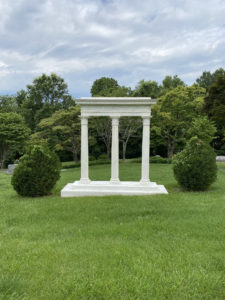The job of a historian is not always a glamorous one, as some people seem to think. Working long hours under the hot sun archiving and researching various gravesites is proof of this. To be fair, however, sitting at a computer or research catalog for hours on end can be equally mind-numbing and boring. Nevertheless, the good historian (or someone hoping to become one) realizes the payoff to diligent research and sees the value of dedication in the benefits of knowledge they create. Working at Oakwood Cemetery for my third week has proved this beyond doubt.
I traveled to the quiet cemetery earlier than I expected Monday (6/22) to meet Lucy Davis and Kay Lewis, two dedicated board members of the cemetery. Leading me on a short guided tour of the grounds, they gave me the instructions I had been waiting to hear for more than a week. I was to find approximately 40 graves, in need of location and documentation. Upon finding them using sizable cemetery blueprints I was to photograph them and annotate various informational material to add to both the cemetery’s and the Bassett Historical Center’s archives (such as grave location upon a lot, possible epigraphs, etc.)
I learned quickly the determination needed to begin work on this project. Despite being located on a hill, Oakwood does not have much of a breeze to balance the heat of the sun. Information wrongly listed or suggested in graveyard documents led me several times to wrong sections of the cemetery for hours looking at incorrect tombs or headstones. Transcription errors, air pollution leading to granite and marble decay, missing markers, erroneous deeds… many graves suffered from one or more of these setbacks. Nevertheless, I managed to finish 20 graves before Friday, halfway through my beginning documentation run. Next week (beginning 6/29) I will be finishing up the 20 remaining graves and beginning several more.
Interestingly, several of the prominent businessmen mentioned in my current reading, Factory Man, are buried at Oakwood. In my surveying, I found the family plot of J.D. Bassett, Jr., the first heir of his father’s massive Bassett Furniture Company. His grave was as immaculate and ornate as the life he lived if Beth Macy’s book is to be believed. Below are a few pictures of his gravesite.
In another cemetery on the opposite end of Henry County, I stopped by one day to see the grave of Margaret Paschal. Margaret was the loving wife of Robert Paschal, the sender of the World War One letters I am currently transcribing for the Bassett Historical Center. The affectionate epitaph on her headstone echoes the undying sentiment those around Margaret (such as Robert, as shown in his letters) had for her. Stopping by for a few minutes encouraged me to press forward and continue the important transcribing process that has been going well so far.
I hope next week to finish Factory Man, continue the steady transcription of letters, and explore more of Oakwood Cemetery’s historic grounds. Here’s to another fantastic week of interning with the Bassett Historical Center!
Pictured: A very confused me at Oakwood Cemetery, orienting my blueprints and looking for a nearby plot.
Pictured: J.D. Bassett, Jr.’s headstone and the beautiful Bassett family plot. Note the family name centered within the frieze.
Pictured: The grave of Margaret Paschal, who remarried following the death of her first husband, Robert Paschal. “To know her,” says the epitaph, “was to love her.”



